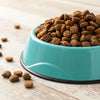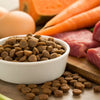How Much Kibble Should a 70 lb Dog Eat? A Comprehensive Guide for Pet Owners
- Houndsy
Table of Contents
- Introduction
- Understanding Dog Feeding Guidelines
- The Importance of Portion Control
- Nutritional Quality Over Quantity
- Establishing a Feeding Routine
- Special Considerations for Senior Dogs
- Treats and Extras
- Conclusion
Introduction
Did you know that nearly 60% of dogs in the United States are considered overweight or obese? This startling statistic highlights the importance of understanding how much food to feed our furry companions, especially when it comes to larger breeds. If you’re a proud owner of a 70 lb dog, you might find yourself asking, "How much kibble should my dog eat?" This question is crucial, as maintaining the right weight is essential for your dog's health and overall well-being.
In this blog post, we aim to provide you with a clear and comprehensive understanding of how much kibble a 70 lb dog should eat daily. We will delve into the various factors that influence your dog's dietary needs, including age, activity level, and health status. By the end of this guide, you will be equipped with the knowledge to create a balanced feeding routine for your dog, ensuring they receive the nutrition they need without the risk of overfeeding or underfeeding.
As we explore this topic, we encourage you to reflect on your own pet feeding routines and how they align with the recommendations provided. Our mission at Houndsy is to simplify and elevate the dog-feeding experience, making it convenient, consistent, and beautiful—starting with the amount of kibble you serve.
Understanding Dog Feeding Guidelines
The Basics of Feeding Guidelines
Feeding guidelines are essential tools that provide a baseline for how much food to give your dog. Most dog food brands include a feeding chart on their packaging, which recommends daily portions based on weight. However, these guidelines are not one-size-fits-all. Each dog is unique, and various factors can affect their specific dietary requirements.
Factors Affecting Food Requirements
- Age: Puppies, adult dogs, and senior dogs have different nutritional needs. Puppies require more calories and nutrients for growth, while senior dogs may need fewer calories due to decreased activity levels.
- Activity Level: An active 70 lb dog will require more calories than a more sedentary one. Regular exercise burns energy, leading to increased caloric needs.
- Health Conditions: If your dog has specific health issues (e.g., obesity, diabetes), their dietary requirements might differ. Always consult your veterinarian for tailored advice.
- Type of Food: Different dog foods have varying calorie contents. For instance, a calorie-dense formula may require smaller portions compared to a lower-calorie option.
Calculating Daily Food Intake
To calculate how much kibble your 70 lb dog should eat, a general guideline suggests that adult dogs need about 30 calories per pound of body weight for maintenance. For a 70 lb dog, this would mean:
30 calories/pound x 70 pounds = 2,100 calories/day
Now, if your dog food contains 400 calories per cup, you would divide the total calorie requirement by the calorie content of the food:
2,100 calories ÷ 400 calories/cup = 5.25 cups of food per day
Splitting the Daily Intake
Feeding your dog multiple times a day can help maintain a stable metabolism and prevent overeating. If you decide to provide your 70 lb dog with two meals per day, simply divide the daily intake by two:
5.25 cups ÷ 2 meals = 2.625 cups per meal
This approach ensures your dog receives consistent nutrition while minimizing the risk of bloating or digestive issues.
The Importance of Portion Control
Why Portion Control Matters
Maintaining the right portion size is crucial for your dog's health. Overfeeding can lead to obesity and associated health issues, including:
- Joint problems
- Diabetes
- Heart disease
- Reduced lifespan
Conversely, underfeeding can result in malnutrition, leading to energy deficits and impaired immune function. Striking the right balance is essential for your dog's overall well-being.
Monitoring Your Dog's Body Condition Score
To ensure you’re feeding your dog the right amount, consider evaluating their Body Condition Score (BCS). This scoring system assesses your dog's body fat and overall physical condition. A healthy dog should have a defined waist and a visible ribcage without excessive pressure. If your dog falls below or above the ideal BCS, it may be time to adjust their food intake accordingly.
Nutritional Quality Over Quantity
While the quantity of food is important, we must also consider the nutritional quality of the kibble we provide. High-quality dog foods contain better ingredients that lead to improved health and vitality. Look for foods that prioritize whole ingredients, a good balance of proteins, fats, and carbohydrates, and avoid artificial additives or fillers.
At Houndsy, we believe that the right food and feeding routine can elevate your pet’s overall experience. Our flagship product, the Houndsy Kibble Dispenser, is designed to make feeding both convenient and visually appealing. With perfect portion control, our dispenser allows you to provide the right amount of food without any fuss. Explore our Houndsy Kibble Dispenser to enhance your dog-feeding routine.
Establishing a Feeding Routine
Consistency is Key
Dogs thrive on routine. Feeding them at the same time each day can help establish a sense of stability. Most adult dogs benefit from two meals per day, typically spaced 12 hours apart. For a 70 lb dog, this can help regulate their energy levels and prevent overeating.
Recommended Feeding Frequency
The recommended feeding frequency varies based on your dog's age and health status:
- Adult Dogs: Two meals per day (one in the morning and one in the evening).
- Puppies: Three to four meals per day until they are about six months old.
- Senior Dogs: May require fewer meals, depending on their health status.
Special Considerations for Senior Dogs
As dogs age, their nutritional needs may change. Senior dogs may require fewer calories due to reduced activity levels. It's worth consulting with your veterinarian to adjust their portions accordingly. They may recommend a senior-specific dog food that is lower in calories but enriched with joint-supporting ingredients like glucosamine and omega-3 fatty acids.
Monitoring Health Changes
Regular veterinary check-ups become even more critical as dogs age. Monitoring weight and overall health can help adjust their feeding routine and ensure they maintain a healthy lifestyle.
Treats and Extras
Can I Give My Dog Treats?
Treats can be a wonderful way to bond with your dog, but it's essential to consider these additional calories when determining their daily food intake. Treats should make up no more than 10% of your dog's daily caloric intake to avoid disrupting their balanced diet.
Adjusting Portions for Treats
If your dog eats 2,100 calories a day, you should limit treats to about 210 calories. To ensure you're not overfeeding, consider the calorie content of the treats you provide and adjust their daily kibble intake accordingly.
Conclusion
Feeding your 70 lb dog the right amount of kibble is essential for their health and well-being. By understanding the factors that influence their dietary needs, calculating their daily caloric intake, and maintaining a consistent feeding routine, we can help our furry friends thrive. Remember, every dog is unique, and it may take some time to find the perfect balance that works for your pet.
At Houndsy, we strive to simplify and elevate the dog-feeding experience. If you're looking to enhance your routine, consider exploring our Houndsy Kibble Dispenser, designed with convenience and style in mind. Our commitment to quality and design excellence ensures your dog receives the best nutrition possible.
Frequently Asked Questions
How much dry food should I feed my 70 lb dog?
For a 70 lb dog, the general guideline is approximately 5.25 cups of kibble per day, depending on the calorie content of the food. Be sure to adjust based on your dog's specific needs.
What factors affect how much food I should feed my dog?
Factors such as age, activity level, health conditions, and the type of food can all impact how much you should feed your dog.
Should I adjust my dog's food intake as they age?
Yes, as dogs age, their caloric requirements may change, so it's important to consult with your veterinarian for guidance.
Can I give my dog treats? If so, how many?
Yes, treats can be given, but they should not exceed 10% of your dog's daily caloric intake to avoid disrupting their balanced diet.
What if my dog is overweight?
If your dog is overweight, consult your veterinarian for guidance on a weight management plan, which may involve adjusting food portions and providing a diet tailored to help them lose weight healthily.












